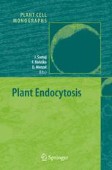Search
Search Results
-
Auxin Transport and Recycling of PIN Proteins in Plants
Polar transport of the phytohormone auxin is mediated by plasma-membrane and endosome localized carrier proteins. PIN proteins are the best...
-
Rab GTPases in Plant Endocytosis
The Rab family is part of the Ras superfamily of small GTPases. In eukaryotes Rab GTPases are present as members of gene families, and the...
-
MDR/PGP Auxin Transport Proteins and Endocytic Cycling
Auxin is an essential regulator of plant growth and development. Polarized transport of auxin is responsible for apical dominance, tropic growth,...
-
Chromatin Modifications in DNA Repair
A requirement of nuclear processes that use DNA as a substrate is the manipulation of chromatin in which the DNA is packaged. Chromatin...
-
Quality control of proteins in the mitochondrion
The quality control of proteins within mitochondria is ensured by conserved and ubiquitous ATP-dependent molecular chaperones and proteases, present...
-
The Hsp60 chaperonins from prokaryotes and eukaryotes
The Hsp60 molecular chaperones (the chaperonins) are essential proteins throughout biology. They can be separated into two evolutionary classes: the...
-
Schizosaccharomyces pombe comparative genomics; from sequence to systems
The fission yeast Schizosaccharomyces pombe is becoming increasingly important as a model for the characterization and study of many globally...
-
The Retinoblastoma Gene Family in Cell Cycle Regulation and Suppression of Tumorigenesis
Since its discovery in 1986, as the first tumor suppressor gene, the retinoblastoma gene (Rb) has been extensively studied. Numerous biochemical and...
-
Senescence and Cell Cycle Control
In response to various stresses, such as telomere shortening during continuous proliferation, oxidative stress, DNA damage and aberrant oncogene...
-
Telomeres in fungi
Telomeres are the functional elements concluding and defining each linear chromosome in eukaryotes. They play an essential role in protecting genetic...
-
Systems Biology: necessary developments and trends
At the end of this definition of Systems Biology through exampling, we discuss ambitions, goals, and challenges relating to this new discipline. We...
-
Control of Cell Proliferation and Growth by Myc Proteins
Myc proteins act as signal transducers that alter cell proliferation in dependence on signals from the extracellular environment. In normal cells,...
-
Comparative genomics and gene finding in fungi -- Supplement
Online Supplement to Chapter 1
-
Regulation of the heat shock response by heat shock transcription factors
The heat shock response is characterized by a rapid and robust increase in heat shock proteins upon exposure to protein-damaging stresses. This...
-
The genome of the filamentous fungus Ashbya gossypii: annotation and evolutionary implications
The 9.2 Mb genome of the filamentous fungus Ashbya gossypii consists of seven chromosomes carrying 4718 protein coding genes, 194 tRNA genes, at...
-
Template-induced protein misfolding underlying prion diseases
Proteins with prion properties are closely associated to a class of fatal neurodegenerative illnesses in mammals and to the emergence and propagation...
-
Methods and Molecular Tools for Studying Endocytosis in Plants---an Overview
Proteins of the endocytosis machinery in plants, such as clathrin and adaptor proteins, were isolated and characterized using combinations of...
-
Tip Growth and Endocytosis in Fungi
Recent advances in molecular cell biology have provided new insights into different cellular processes that all turn out to contribute to...
-
1 Phospholipid synthesis in mammalian cells
Phospholipids are the main components of biological membranes and as such act as the major permeability barrier between cells and the extracellular...
-
2 Phospholipid synthesis and dynamics in plant cells
Phospholipids represent the second family of lipids after the galactolipids in photosynthetic tissues and the first in non-photosynthetic tissues....
